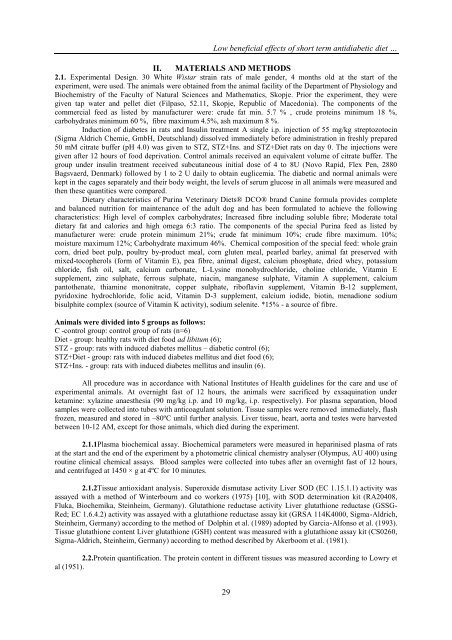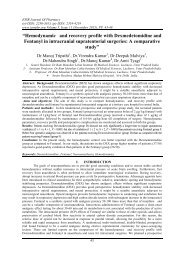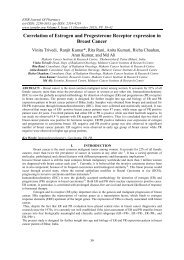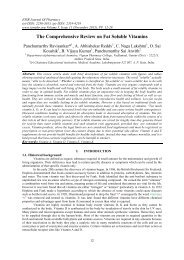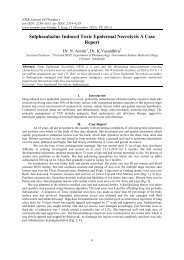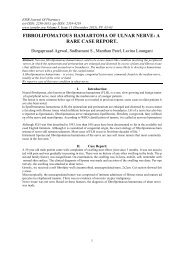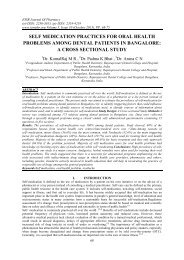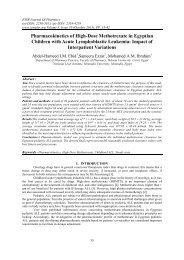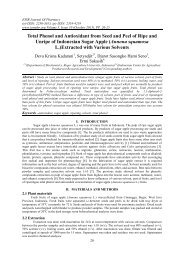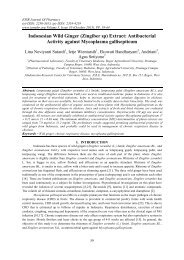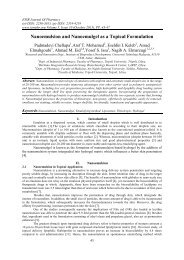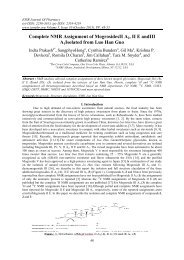Low beneficial effects of short term antidiabetic diet treatment in streptozotocin – induced diabetic rats
- No tags were found...
You also want an ePaper? Increase the reach of your titles
YUMPU automatically turns print PDFs into web optimized ePapers that Google loves.
<strong>Low</strong> <strong>beneficial</strong> <strong>effects</strong> <strong>of</strong> <strong>short</strong> <strong>term</strong> <strong>anti<strong>diabetic</strong></strong> <strong>diet</strong> …II. MATERIALS AND METHODS2.1. Experimental Design. 30 White Wistar stra<strong>in</strong> <strong>rats</strong> <strong>of</strong> male gender, 4 months old at the start <strong>of</strong> theexperiment, were used. The animals were obta<strong>in</strong>ed from the animal facility <strong>of</strong> the Department <strong>of</strong> Physiology andBiochemistry <strong>of</strong> the Faculty <strong>of</strong> Natural Sciences and Mathematics, Skopje. Prior the experiment, they weregiven tap water and pellet <strong>diet</strong> (Filpaso, 52.11, Skopje, Republic <strong>of</strong> Macedonia). The components <strong>of</strong> thecommercial feed as listed by manufacturer were: crude fat m<strong>in</strong>. 5.7 % , crude prote<strong>in</strong>s m<strong>in</strong>imum 18 %,carbohydrates m<strong>in</strong>imum 60 %, fibre maximum 4.5%, ash maximum 8 %.Induction <strong>of</strong> diabetes <strong>in</strong> <strong>rats</strong> and Insul<strong>in</strong> <strong>treatment</strong> A s<strong>in</strong>gle i.p. <strong>in</strong>jection <strong>of</strong> 55 mg/kg streptozotoc<strong>in</strong>(Sigma Aldrich Chemie, GmbH, Deutschland) dissolved immediately before adm<strong>in</strong>istration <strong>in</strong> freshly prepared50 mM citrate buffer (pH 4.0) was given to STZ, STZ+Ins. and STZ+Diet <strong>rats</strong> on day 0. The <strong>in</strong>jections weregiven after 12 hours <strong>of</strong> food deprivation. Control animals received an equivalent volume <strong>of</strong> citrate buffer. Thegroup under <strong>in</strong>sul<strong>in</strong> <strong>treatment</strong> received subcutaneous <strong>in</strong>itial dose <strong>of</strong> 4 to 8U (Novo Rapid, Flex Pen, 2880Bagsvaerd, Denmark) followed by 1 to 2 U daily to obta<strong>in</strong> euglicemia. The <strong>diabetic</strong> and normal animals werekept <strong>in</strong> the cages separately and their body weight, the levels <strong>of</strong> serum glucose <strong>in</strong> all animals were measured andthen these quantities were compared.Dietary characteristics <strong>of</strong> Pur<strong>in</strong>a Veter<strong>in</strong>ary Diets® DCO® brand Can<strong>in</strong>e formula provides completeand balanced nutrition for ma<strong>in</strong>tenance <strong>of</strong> the adult dog and has been formulated to achieve the follow<strong>in</strong>gcharacteristics: High level <strong>of</strong> complex carbohydrates; Increased fibre <strong>in</strong>clud<strong>in</strong>g soluble fibre; Moderate total<strong>diet</strong>ary fat and calories and high omega 6:3 ratio. The components <strong>of</strong> the special Pur<strong>in</strong>a feed as listed bymanufacturer were: crude prote<strong>in</strong> m<strong>in</strong>imum 21%; crude fat m<strong>in</strong>imum 10%; crude fibre maximum. 10%;moisture maximum 12%; Carbohydrate maximum 46%. Chemical composition <strong>of</strong> the special feed: whole gra<strong>in</strong>corn, dried beet pulp, poultry by-product meal, corn gluten meal, pearled barley, animal fat preserved withmixed-tocopherols (form <strong>of</strong> Vitam<strong>in</strong> E), pea fibre, animal digest, calcium phosphate, dried whey, potassiumchloride, fish oil, salt, calcium carbonate, L-Lys<strong>in</strong>e monohydrochloride, chol<strong>in</strong>e chloride, Vitam<strong>in</strong> Esupplement, z<strong>in</strong>c sulphate, ferrous sulphate, niac<strong>in</strong>, manganese sulphate, Vitam<strong>in</strong> A supplement, calciumpantothenate, thiam<strong>in</strong>e mononitrate, copper sulphate, rib<strong>of</strong>lav<strong>in</strong> supplement, Vitam<strong>in</strong> B-12 supplement,pyridox<strong>in</strong>e hydrochloride, folic acid, Vitam<strong>in</strong> D-3 supplement, calcium iodide, biot<strong>in</strong>, menadione sodiumbisulphite complex (source <strong>of</strong> Vitam<strong>in</strong> K activity), sodium selenite. *15% - a source <strong>of</strong> fibre.Animals were divided <strong>in</strong>to 5 groups as follows:C -control group: control group <strong>of</strong> <strong>rats</strong> (n=6)Diet - group: healthy <strong>rats</strong> with <strong>diet</strong> food ad libitum (6);STZ - group: <strong>rats</strong> with <strong>in</strong>duced diabetes mellitus <strong>–</strong> <strong>diabetic</strong> control (6);STZ+Diet - group: <strong>rats</strong> with <strong>in</strong>duced diabetes mellitus and <strong>diet</strong> food (6);STZ+Ins. - group: <strong>rats</strong> with <strong>in</strong>duced diabetes mellitus and <strong>in</strong>sul<strong>in</strong> (6).All procedure was <strong>in</strong> accordance with National Institutes <strong>of</strong> Health guidel<strong>in</strong>es for the care and use <strong>of</strong>experimental animals. At overnight fast <strong>of</strong> 12 hours, the animals were sacrificed by exsaqu<strong>in</strong>ation underketam<strong>in</strong>e: xylaz<strong>in</strong>e anaesthesia (90 mg/kg i.p. and 10 mg/kg, i.p. respectively). For plasma separation, bloodsamples were collected <strong>in</strong>to tubes with anticoagulant solution. Tissue samples were removed immediately, flashfrozen, measured and stored <strong>in</strong> <strong>–</strong>80ºC until further analysis. Liver tissue, heart, aorta and testes were harvestedbetween 10-12 AM, except for those animals, which died dur<strong>in</strong>g the experiment.2.1.1Plasma biochemical assay. Biochemical parameters were measured <strong>in</strong> hepar<strong>in</strong>ised plasma <strong>of</strong> <strong>rats</strong>at the start and the end <strong>of</strong> the experiment by a photometric cl<strong>in</strong>ical chemistry analyser (Olympus, AU 400) us<strong>in</strong>grout<strong>in</strong>e cl<strong>in</strong>ical chemical assays. Blood samples were collected <strong>in</strong>to tubes after an overnight fast <strong>of</strong> 12 hours,and centrifuged at 1450 × g at 4ºC for 10 m<strong>in</strong>utes.2.1.2Tissue antioxidant analysis. Superoxide dismutase activity Liver SOD (EC 1.15.1.1) activity wasassayed with a method <strong>of</strong> W<strong>in</strong>terbourn and co workers (1975) [10], with SOD de<strong>term</strong><strong>in</strong>ation kit (RA20408,Fluka, Biochemika, Ste<strong>in</strong>heim, Germany). Glutathione reductase activity Liver glutathione reductase (GSSG-Red; EC 1.6.4.2) activity was assayed with a glutathione reductase assay kit (GRSA 114K4000, Sigma-Aldrich,Ste<strong>in</strong>heim, Germany) accord<strong>in</strong>g to the method <strong>of</strong> Dolph<strong>in</strong> et al. (1989) adopted by Garcia-Alfonso et al. (1993).Tissue glutathione content Liver glutathione (GSH) content was measured with a glutathione assay kit (CS0260,Sigma-Aldrich, Ste<strong>in</strong>heim, Germany) accord<strong>in</strong>g to method described by Akerboom et al. (1981).2.2.Prote<strong>in</strong> quantification. The prote<strong>in</strong> content <strong>in</strong> different tissues was measured accord<strong>in</strong>g to <strong>Low</strong>ry etal (1951).29


